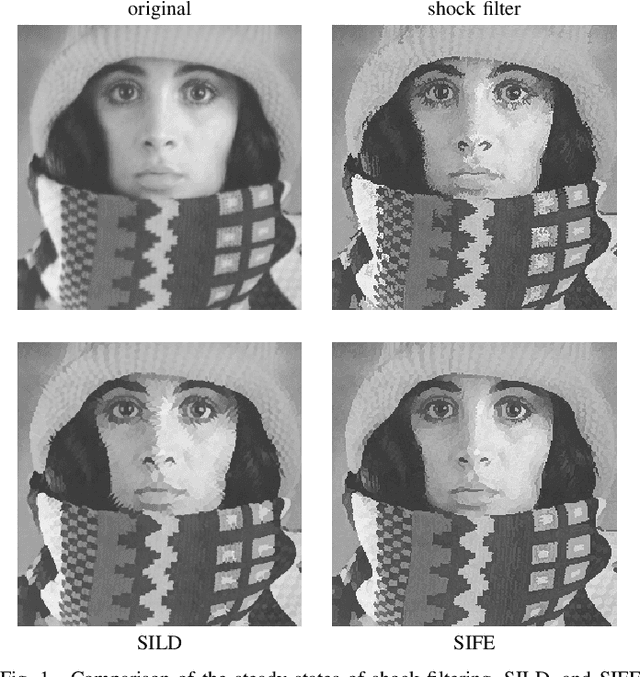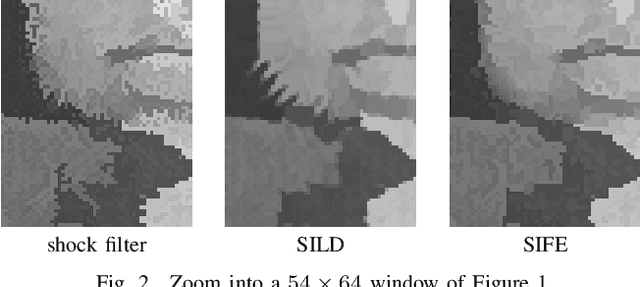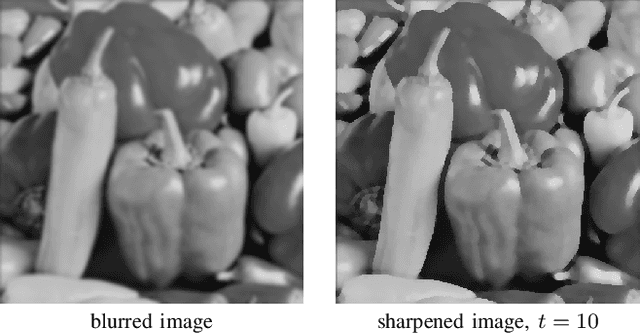Kristina Schaefer
Regularised Diffusion-Shock Inpainting
Sep 15, 2023Abstract:We introduce regularised diffusion--shock (RDS) inpainting as a modification of diffusion--shock inpainting from our SSVM 2023 conference paper. RDS inpainting combines two carefully chosen components: homogeneous diffusion and coherence-enhancing shock filtering. It benefits from the complementary synergy of its building blocks: The shock term propagates edge data with perfect sharpness and directional accuracy over large distances due to its high degree of anisotropy. Homogeneous diffusion fills large areas efficiently. The second order equation underlying RDS inpainting inherits a maximum--minimum principle from its components, which is also fulfilled in the discrete case, in contrast to competing anisotropic methods. The regularisation addresses the largest drawback of the original model: It allows a drastic reduction in model parameters without any loss in quality. Furthermore, we extend RDS inpainting to vector-valued data. Our experiments show a performance that is comparable to or better than many inpainting models, including anisotropic processes of second or fourth order.
Diffusion-Shock Inpainting
Mar 16, 2023Abstract:We propose diffusion-shock (DS) inpainting as a hitherto unexplored integrodifferential equation for filling in missing structures in images. It combines two carefully chosen components that have proven their usefulness in different applications: homogeneous diffusion inpainting and coherence-enhancing shock filtering. DS inpainting enjoys the complementary synergy of its building blocks: It offers a high degree of anisotropy along an eigendirection of the structure tensor. This enables it to connect interrupted structures over large distances. Moreover, it benefits from the sharp edge structure generated by the shock filter, and it exploits the efficient filling-in effect of homogeneous diffusion. The second order equation that underlies DS inpainting inherits a continuous maximum-minimum principle from its constituents. In contrast to other attractive second order inpainting equations such as edge-enhancing anisotropic diffusion, we can guarantee this property also for the proposed discrete algorithm. Our experiments show a performance that is comparable to or better than many linear or nonlinear, isotropic or anisotropic processes of second or fourth order. They include homogeneous diffusion, biharmonic interpolation, TV inpainting, edge-enhancing anisotropic diffusion, the methods of Tschumperl\'e and of Bornemann and M\"arz, Cahn-Hilliard inpainting, and Euler's elastica.
Stabilised Inverse Flowline Evolution for Anisotropic Image Sharpening
Jul 20, 2022


Abstract:The central limit theorem suggests Gaussian convolution as a generic blur model for images. Since Gaussian convolution is equivalent to homogeneous diffusion filtering, one way to deblur such images is to diffuse them backwards in time. However, backward diffusion is highly ill-posed. Thus, it requires stabilisation in the model as well as highly sophisticated numerical algorithms. Moreover, sharpening is often only desired across image edges but not along them, since it may cause very irregular contours. This creates the need to model a stabilised anisotropic backward evolution and to devise an appropriate numerical algorithm for this ill-posed process. We address both challenges. First we introduce stabilised inverse flowline evolution (SIFE) as an anisotropic image sharpening flow. Outside extrema, its partial differential equation (PDE) is backward parabolic in gradient direction. Interestingly, it is sufficient to stabilise it in extrema by imposing a zero flow there. We show that morphological derivatives - which are not common in the numerics of PDEs - are ideal for the numerical approximation of SIFE: They effortlessly approximate directional derivatives in gradient direction. Our scheme adapts one-sided morphological derivatives to the underlying image structure. It allows to progress in subpixel accuracy and enables us to prove stability properties. Our experiments show that SIFE allows nonflat steady states and outperforms other sharpening flows.
 Add to Chrome
Add to Chrome Add to Firefox
Add to Firefox Add to Edge
Add to Edge